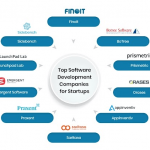Fueling Software Startup Success: 9 Proven Ways to Build Fast, Cut Costs, and Maximize Growth

Let’s say you have 3 developers and a pile of backlog in the product roadmap. You know time is of the essence and time to market will be very critical for gaining that traction you need to survive.
But how do you do it with 3 developers?
If somehow, you happen to build, you know the quality will get messed up and technical debt will come back to haunt you later.
Having been part of 100+ startups’ development efforts and built a couple of my own, I thought to list out some of the most critical aspects that I have seen playing an important role in building fast, reducing the cost, and driving scale.
Niche down
This is a mistake most founders starting up are aware of and yet happen to make!
Except when software founders come from a specific vertical or sector, they struggle to identify the focus area when building the envisioned product. The best way is always to niche down and build a targeted product rather than building a serve-all, it-has-everything product.
Indeed, entrepreneurs are inspired by the idea that may have a broad application for a targeted industry, so, they do not tend to niche down. But to ensure a sustainable presence in the competitive scenario, niching down and riveting focus on core offerings can prove highly valuable.
Co-founder and Chief Investment Officer of IBI Spikes Fund while in this context remarks, “Do you want to go make a CRM that anyone could use, or do you want to make a CRM for dentists?” He further adds “Today you definitely want to make a CRM for dentists and the niche-is the better. If you focus on solving particular problems that dentists have, you won’t face competition.”
These words nicely capture the entire essence of building products for a niche, which is essential to register steady growth. Focusing on a niche may not necessarily make you a unicorn, but then you can never ever imagine becoming a unicorn without narrowing it down to a niche.
Build in pieces
Startups that build a prototype turn out to be much more successful. No matter how clear your idea and vision may be, building a prototype is the quickest and easiest way to identify and fill missing gaps. This applies equally well to both scenarios – when you are developing a disruptive product or a repurposed solution.
We all know the benefits of MVP development for startups and while no entrepreneur is immune to making mistakes, prototyping allows you to do so at a lower cost before making more time and financial commitments.
Father of Visual Basic, Alan Cooper has famously quoted “The value of a prototype is in the education it gives you, not in the code itself.” By education, Cooper refers to the value that gets added to every process linked to product development, surpassing the traditional value that it adds to product features.
For instance, prototyping helps in creating a positive impression in front of investors, as you can demonstrate your value proposition through the proposed solution. Hence, your prototype doesn’t just help refine and validate ideas, but it helps you sell your vision.
The project scope conondrum
“It is the uncontrolled expansion to product or project scope without adjustments to time, cost, and resources,” says Oliver Yarborough, a speaker, author, and trainer on project management, when talking in the context of project scope creep.
A solid understanding of project scope and technical know-how of managing it is what entrepreneurs need to possess. Not being clear about the project scope can mean that you are vulnerable to distractions that the competition or prospecting happens to cause.
How?
It’s simple, getting overwhelmed, you incorporate features that sound or feel like a need but are just bells and whistles and hardly add any value or offer any competitive advantage.
With clear project scope, iterations take place in a systematic manner, and there are no last-minute changes. You follow the project timelines and your budget doesn’t overshoot.
Choose the development approach wisely
When the question of choosing a development methodology arises, most people would shout out loud- GO AGILE.
And that’s because the benefits of using agile development for startups are widely known. But is it really always a good fit for startups of all types?
As a startup, you need to consider several aspects to judge the fitment of a development approach to your project idea. As such, the all-encompassing capabilities of agile do not always hold answers.
As startups operate under tight constraints of time and budget, the waterfall can provide an advantage, whereas Agile is more suitable to scenarios where businesses are ready to participate in the continuous loop of offering feedback and rendering changes to the product.
In other words, as startups turn into mature enterprises, they can consider shifting their development strategy, moving from waterfall to agile. In its nascent years, Microsoft relied on Waterfall, as the model provided a linear structure for organizing and controlling the project. It was useful for stable requirements where development teams went on adding incremental changes to the core functionality. The information system providers of the U.S. Department of Defense, too, followed a precise Waterfall process.
Subsequently, projects with inevitable uncertainties and changes in design, propelled the move towards Agile principle, involving methodologies such as Scrum, Lean, and RAD.
In a nutshell, both Waterfall and Agile are viable methodologies, depending on the stage of the enterprise life cycle (ELC) that a startup reaches.
The Code
Code optimization is one crucial element of the entire coding value chain that is vital to speeding up code delivery. Let’s see how Airbnb, today’s famous online marketplace, as a startup, optimized its code to build a stable, scalable, and reliable platform.
As Airbnb’s user base continued growing, it realized the need to achieve faster page load times and achieve scalability. The solution lay in the codebase.
To optimize the code, Airbnb carried out a series of actions. The first step was focused on improving developer efficiency. Next, efforts were concentrated on optimizing the debugging time and streamlining critical code paths.
In general, following certain best practices can help in meticulously handling the code optimization process. These practices include:
- Reviewing code in small batches
- Using automation for review
- Conducting multiple checks before submitting code for review
- Having a code review checklist
- Having metrics to measure code effectiveness
With a standard process set for code review and optimization, you expedite the production of clean code, reduce the need for rework, and synchronize code well with the documentation.
Need Help With Your
Code Optimization?
- Proven
- Transparent
- Dependable
Improving with automation
Automating end-to-end testing has been key to success for companies like SpaceX and Robinhood which had identified the need to automate in their early years. They adopted automation while accompanying it with change impact analysis which executes tests for each piece of code. SpaceX has even started using AI and machine learning to optimize continuous testing and decrease release times.
As a software development agency ourselves, we are seeing that CI/CD is no longer a choice, it’s imperative to skyrocket the efficiency of your testing process. Merging codes, executing test runs, and carrying out changes – which are all crucial for faster development – are all automated and expedited by the coming of CI/CD.
Most importantly, since CI/CD carries out continuous testing by dividing the code into parts, no single bug goes undetected before the code moves into production. And since the process is optimized and not prone to errors, you do not incur any additional cost for fixing bugs.
Relying on the proven tools
The entire gamut of tools required for software development comprises more than build tools and an integrated development environment (IDE). You need tools to track bugs, regulate access to source control, manage the project, test, and deploy.
To arrive at the most suitable choice for each of the categories without hassling and wasting time demands a prior understanding of a tool.
While the use of certain tools dominates the software development space, you may encounter situations where you will have to carefully select a tool. For instance, considering the versatility of JIRA, nearly 50% of software development teams use it. The number is good to give you confidence in its applicability to your project and thus there is a high possibility it might be a good fit for you too.
Never act with a singular view of identifying one good tool for development as it would hardly help you in achieving speed and scale. Conduct research and connect with an expert to build a perfect tech stack.
The case of technical debt
Ward Cunningham, the co-author of the Manifesto for Agile Software Development, coined the term “technical debt” more than three decades back, but the term still holds the same significance.
Startups don’t have any scope for rework due to resource crunch and deadline pressures, which may prevent developers from producing clean codes. With a focus on short-term goals, the development team tends to lose their attention on long-term vision. The ignorance and constant shuffling result in technical debt.
When going unmanaged technical debt can prove catastrophic as Stripe’s “The Developer Coefficient” report cites. As per the analysis of the report, tech debt consumes 42% of a developer’s weekly work time, which is 13.5 hours per week. Interestingly, 52% of enterprises believe that technical debt is a factor that hinders the productivity of their developers.
Startups thus must apply every effort to avoid technical debt, as it can result in product destabilization. So, your team might be working on development for a year and lose another year for merging and stabilizing as a result of technical debt. Usually, this results in:
- Requiring more workforce
- Disturbed development cycle
- Sudden spike in costs which you incur for a long time
- Inability to adapt to shifting market requirements
Given these implications, entrepreneurs do not have any choice rather than validating code right from the beginning.
Scaling up or down the team, flexibly!
Building faster is a challenge and scaling up a bigger one.
Most times, when building the product as a startup, how to reduce software development cost remains a big question for founders. You need to optimize resources for that while hiring multiple developers to expedite product development. Outsourcing and offshore development with the right partner becomes key in such a situation especially when the internal cost of development is quite high or hiring in-house is a challenge.
The next challenge is during scale-up ops when you have funds and still scaling up is a challenge either because of talent dearth or hiring cycles etc.
Harvard Business Review’s Ideacast, featuring a conversation between Curt Nickish and Jeffrey Rayport explains how tech companies find themselves immensely successful on the way to product market fit, however, stumble in the scaling phase.
Scale-up ops not only depends on faster hiring but hiring right.
As Daniel J. Weinfurter, a founding member of various firms, who previously taught at Kellog School of Management, while discussing startups, notes, “While the product or the service remains important what ends up driving the ability to scale is not the product or the service per se, but the team of people that are put in place to serve the clients and build the product or service.”
“When you have the right people, you get the product right and everything falls in line, but if you don’t have this right, the opposite happens. It’s a painful and expensive mess,” goes Weinfurter further.
And thus, it’s super critical that the right people are onboarded at the right stages.
Some of the common challenges we have seen software companies face are-
- Hiring faster remains a challenge i.e. shorter developer hiring cycles
- Internal tech expertise i.e. no technology lead in-house. This happens especially when founders are subject matter experts but lack technology knowledge
- Have limited resources(funds) and thus can’t hire good talent
- Can hire but lack a refined, proven process to hire top talent at a reasonable cost. Most either end up with the wrong talent or hire at a very high cost.
And we have found the following working very nicely with many software startups:
- Hiring a virtual CTO who works remotely, is always accessible, and actively contributes. A virtual CTO does not work as a full-time employee but carries similar responsibilities to an in-house CTO, bringing diverse expertise and an external perspective
- Hiring an offshore development company as a development partner. Though thorough vetting is required here, if you end up with the right partner, building and scaling up becomes less challenging
- Augmenting your team i.e. hire remote devs or an agency to support your internal team. Most times, an offshore team would have multiple developers on the bench, and scaling up or down your team will be easier. Also, software developer rates in countries you augment to can also be a big competitive advantage.
- Another trend we have seen especially when founders don’t have tech expertise is issuing equity to their outsourced partner. This not only brings the next level of accountability and shared responsibility but also makes the agency share the product’s success.
To sum up
There are challenges when it comes to building faster while reducing development costs and scaling; the process can become seamless and fun when you have the right frameworks and tactics in place.
The tactics we have listed are proven and we not only hope you found them helpful but also that they help you in achieving great success.
Need Help with
Startup's Development?
- Proven
- Transparent
- Dependable


